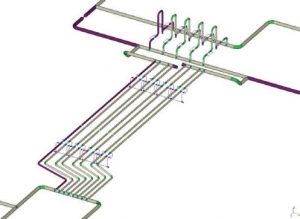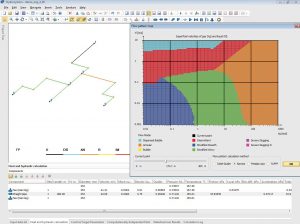PASS Hydrosystem


Overview
PASS/HYDROSYSTEM provides diameter selection, heat and hydraulic analysis of steady state and transient flow in piping systems of any complexity, including networks with loops. It also covers the most dangerous type of transitional flow related to liquid surge (water hammer).
PASS/HYDROSYTEM offers three configurations to meet your specific needs for piping system design and analysis:
- PASS/HYDROSYSTEM Complete
- PASS/HYDROSYSTEM Pressure&Heat
- PASS/HYDROSYSTEM Pressure
Key advantages
- Fast start for new employees
- Extensive analysis capabilities
- Integration with popular CAD tools
- Calculation engine for all necessary fluid properties and phase equilibrium
- Flexible licensing & affordable pricing
Description
Embedded Intelligence
 PASS/HYDROSYSTEM combines sophisticated calculation capabilities with ease-of-use to deliver fluid flow and heat transfer simulation and sizing of any piping network for any design stage by “regular” engineers and designers.
PASS/HYDROSYSTEM combines sophisticated calculation capabilities with ease-of-use to deliver fluid flow and heat transfer simulation and sizing of any piping network for any design stage by “regular” engineers and designers.
First introduced in 1977 and blessed by piping hydraulic world-known guru Idelchik, PASS/ HYDROSYSTEM has since evolved into one of most powerful piping flow analysis tools.
Process and piping engineers of more than 600 companies now use the software every day.
New employees can begin performing piping hydraulic and thermal analysis in days.
Broad Applicability
Pipelines analyzed include:
- Process piping systems at plants, storage facilities, pumping and compressor stations
- Plant utility piping systems such as steam, water, compressed air, inert gases, fuel, refrigerants and others
- Piping in mechanical industries such as aerospace, ship building, boiler, turbines, and more
- Oil and gas upstream and midstream pipelines
- Outdoor piping networks including district heating, water and gas distribution
- Other piping networks
PASS/HYDROSYSTEM includes flow assurance calculations, including severe slugging prediction and gas hydrate formation prediction.
PASS/HYDROSYSTEM simulates most complex types of multiphase flow, including gas-liquid flow and slurry flow.
PASS/HYDROSYSTEM provides flow rate calculation and sizing based on the most effective numerical algorithms for network analysis and optimization making it effective for analysis of large scale complex piping networks.
Increased Productivity
 An easy to use GUI and multi-variant representation of the model with customizable level of detailing and type of graphics (process diagrams, one-line, 3D representation) allows effective use of PASS/HYDROSYSTEM on different design phases, from feasibility study to detailed design. Results representation on the pipeline model and automated and customizable report generation help the user to understand piping behavior.
An easy to use GUI and multi-variant representation of the model with customizable level of detailing and type of graphics (process diagrams, one-line, 3D representation) allows effective use of PASS/HYDROSYSTEM on different design phases, from feasibility study to detailed design. Results representation on the pipeline model and automated and customizable report generation help the user to understand piping behavior.
Extensive analysis capabilities, along with integration with popular CAD tools and within the PASS suite, makes PASS/ HYDROSYSTEM an ideal component for any piping system design workflow.
PASS/HYDROSYSTEM can import piping models ready for analysis from AVEVA PDMS and E3D, PASS/START-PROF, and PCF formats, as well as export piping model to PASS/START-PROF. It can also calculate and export unbalanced forces from water hammer to PASS/START-PROF, CAESAR II and other piping stress analysis software.
Powerful Capabilities
In order to analyze a piping system for hydraulic and thermal effects, it is necessary to simulate its behavior on three scale levels: pipe cross section, pipe/branch run, and the whole piping network – and then link and solve these models together.
At the cross-sectional scale, it is necessary to define the type of fluid flow (laminar, turbulent, choked, or subsonic), flow pattern for multiphase flow (stratified, annular, intermitted, etc.), and the specifics of heat exchange between fluid and the environment through pipe wall and thermal insulation. This knowledge is then used when calculating integral parameters of the flow and heat exchange (pressure gradient, heat losses per length, etc.) and following up how all fluid parameters change along the pipe/ branch and all over the network. This would be impossible without access to the most reliable thermodynamic data provided by the software.
PASS/HYDROSYSTEM provides a calculation engine for all necessary fluid properties and phase equilibrium on the basis of fluid composition, for a wide spectrum of fluids and applications.
Thermodynamics libraries used include: the advanced proprietary library for refining and petrochemical industry; the library on the base of the International Association of the Properties of Water and Steam formulation; the most accurate modern GERG-2008 library for natural gas; access to the Simulis Thermodynamics calculation server by ProSim SA (for chemical, biochemical and other industries); and PVTSim Hydrate Open Structure Library by Calsep.
PASS/HYDROSYSTEM uses the most advanced models/algorithms and libraries for all level of simulation (both proprietary and from famous researchers/developers from all over the world).
 This includes minor losses correlations by Idelchik, Miller, and Ito; multiphase flow models by Chisholm, Friedel, Taitel, Barnea, and Tulsa University Fluid Flow Project research group; DHLLDV slurry flow model by Delft University of Technology; Todini Global Gradient Algorithm for network solver; Powell derivative-free method for optimization; and many others.
This includes minor losses correlations by Idelchik, Miller, and Ito; multiphase flow models by Chisholm, Friedel, Taitel, Barnea, and Tulsa University Fluid Flow Project research group; DHLLDV slurry flow model by Delft University of Technology; Todini Global Gradient Algorithm for network solver; Powell derivative-free method for optimization; and many others.
PASS/HYDROSYSTEM can be delivered in different configurations to evaluate the piping pressure and thermal effects.
PASS/HYDROSYSTEM Complete provides comprehensive hydraulic and thermal analysis and related sizing calculations for piping systems of any complexity.
PASS/HYDROSYSTEM Pressure&Heat provides simulation and sizing of any piping network for single phase steady state flow and thermal conditions.
PASS/HYDROSYSTEM Pressure provides simulation and sizing of any piping network for pressure effects related to single phase steady state flow conditions.
Affordable pricing options are tailored for the needs of all users, from individual engineers to corporations of all sizes.
